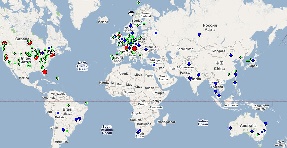...
The main purpose of TULIP Central Reflector is to proxy the TULIP queries to PlanetLab's Scriptroute Service. It may also be extended to issue all queries. This decision will be related to speed of execution and security among other things. The PlanetLab Scriptroute service provides a cookie which works for a single IP address only. So in this way all the requests will be issued from the Central reflector and the responses will be sent back to the TULIP JNLP Client. Here is a map of Planet Lab servers.
Implementation
| Wiki Markup |
|---|
The TULIP Central reflector will be a CGI Script (reflector.cgi) deployed at SLAC. The TULIP client will issue a single request and the Reflector will go ahead and probe all the landmarks in that region*\[1\] and return the results to the TULIP Client. Probing the target site from more vantage points may give us a better estimate of its location. |
...
There are about 60 SLAC/Looking Glass landmarks, and about 156 PlanetLabs landmarks. We are working on filtering the latter to remove non- or poorly respodning landmarks. The PlanetLab landmarks send 10 pings very quickly, whereas the SLAC/Looking Glass landmarks send five 56 byte pings with one second between them, they will also wait for a deadline time of 30 seconds for pings to be replied to.
You can see There is a Google map of the PlanetLab and SLAC/Looking Glass landmarks by clicking below or by going to: http://www.slac.stanford.edu/comp/net/wan-mon/viper/tulip_googlemap.htm
Tiering
To reduce the network impact and reduce the initial rough estimate time, we also break the landmarks into two tiers. Tier0 landmarks are used to identify the region for the target. Then tier1 hosts for that region can be used to more exactly locate the target. Tier0 hosts are chosen as being at the edges of the region, being well connected, highly reliable and quick to respond. We currently only define tier0 hosts for North America and Europe. In other regions all the landmarks are regarded as tier0. There are about 8 tier0 hosts for North America and 4 for Europe. This reduces the number of landmarks to make measurements from with a tier0 request since there are over 100 landmarks in either North America or Europe.
...
